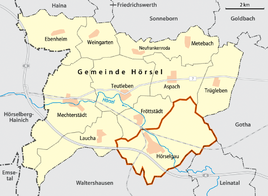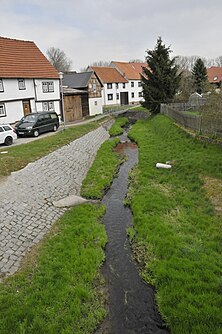Hörselgau
|
Hörselgau
Rural community of Hörsel
|
|
|---|---|
| Coordinates: 50 ° 55 ′ 11 ″ N , 10 ° 35 ′ 6 ″ E | |
| Height : | 299 m above sea level NN |
| Area : | 11.53 km² |
| Residents : | 1209 (December 31, 2014) |
| Population density : | 105 inhabitants / km² |
| Incorporation : | December 1, 2011 |
| Postal code : | 99880 |
| Area code : | 03622 |
|
Hörselgau within the rural community of Hörsel
|
|
|
The Volbach in the town center, near the church
|
|
Hörselgau is a district of the rural community Hörsel and its administrative seat.
geography
Hörselgau is located in the north-west of the Thuringian district of Gotha . Neighboring towns are Fröttstädt in the north-west, Laucha in the west, Waltershausen in the south-west and Wahlwinkel in the south-east. The eponymous river Hörsel meanders along the northeastern edge of the village from southeast to northwest. About two kilometers south-east, but already in Waltershausen's area, is the Hörselgau pond , whose overflow, the Volbach, flows into the Hörsel near Hörselgau. Beyond the Hörsel, the Mühlbach is branched off, which operated the “Untermühle” at the level of the village.
history
Finds of cord and ribbon ceramics testify to the settlement of the Hörsel lowlands as early as 8000 years ago, and traces of the Aunjetitz culture were also found at the Hörselgau pond . The place name goes back to the Franconian times of Thuringia, when the country was still divided into Gaue. Hörselgau is to be interpreted as a Gau on the Hörsel . As usual, a former noble family used the place name for their own name ( noble family von Hörselgau ). The place name was first mentioned in a document in Akkon in 1215 at the same time as a Marshal of the Teutonic Order , Ludwig von Hörselgau . Hartwig von Hörselgau served as a witness in the issuing of landgrave documents in 1220 and 1227. A later living nobleman, also named Ludwig von Hörselgau, also joined the Teutonic Order in 1438 and sold his property, of which no remains have been preserved and which is the last surviving evidence of the family's existence. Her castle is said to have been not far from the parish apartment on the Hörsel . In the following years Hörselgau belonged to the Tenneberg Office , which from 1640 was in the Duchy of Saxony-Gotha .
On March 18, 1994, Hörselgau was one of the seven founding and, from November 7, 2003, the seat of the Hörsel administrative community . By order of the Thuringian State Parliament on 16 November 2011, the administrative community Hörsel was dissolved on December 1, 2011, through a voluntary merger of ten previously independent municipalities Aspach , Ebenheim , Fröttstädt , Hörselgau, Laucha , Mechterstädt , Metebach , Teutleben , Trügleben and Weingarten the Rural community of Hörsel will be newly formed.
Population development
Development of the population (December 31st each) :
|
|
|
|
|
- Data source: Thuringian State Office for Statistics
politics
Former mayor
As a result of the elections to the municipal councils on May 6, 1990 (see final report) and the resulting mayoral election, Rolf Frühauf (then CDU) was elected full-time mayor with effect from May 17, 1990 and confirmed by the district administrator of the Gotha district. The legal situation of the GDR at that time largely applied until German reunification on October 3, 1990.
In the mayoral election on June 12, 1994, Rolf Frühauf was elected honorary mayor of the community. He was confirmed in office in the mayoral elections on June 13, 1999, June 27, 2004 and June 6, 2010. His term of office began on July 1, 2010. With the conversion to a rural community, he became mayor of the district on December 1, 2011 (with a term of office until 2016).
- 1994–2011: Rolf Frühauf ( CDU / independent)
Culture and sights
Buildings
- The church of St. Bonifatius in Hörselgau was built between 1783 and 1785, after only the steeple of the medieval church was preserved after two fires in 1638 and 1640 in the Thirty Years' War . In the new building, only the approximately 30 meter high tower with its slate roof from 1699 remained, while the approximately 22 meter long and eleven meter wide nave with its characteristic mansard roof was completely rebuilt. The middle shrine of a former winged altar with the almost life-size sculptures of the namesake of the church Bonifatius as well as Michael and Cyriacus is particularly worth seeing . The Dehio handbook deals with this gem by assigning it to the environment of Tilman Riemenschneider . The precious shrine was restored in 1985. The interior also has a circumferential double gallery into which the pulpit altar is integrated. In 1986 the interior of the church was repainted. In 1806 the church received a new organ from Johann Michael Hesse's Dachwig workshop .
- A war memorial in front of the church commemorates the 46 fallen soldiers of the First World War and the 49 fallen and 27 missing soldiers of the Second World War from Hörselgau.
- A communal grave with a memorial cross and the names of four German soldiers who died on April 3, 1945 and three soldiers who died on April 17 (two weeks after the site was occupied by US troops) is located on the cemetery.
traffic
Hörselgau has its own stop on the Fröttstädt - Friedrichroda railway line ( Friedrichrodaer Bahn ) and has a direct motorway access from the Waltershausen junction of the A 4 . The “Hörselgau” motorway service station is on the north side of the A4.
This means that the industrial park and the “Marktal” logistics location can be reached directly without having to drive through town. The logistics advantage of the industrial location was highlighted in a study by the University of Erlangen-Nuremberg in 1998 , according to which several important locations in Germany were examined and Hörselgau took the top spot. Half of the “Waltershausen Nord” industrial park, which can also be reached directly from the Waltershausen motorway junction without having to drive through town, is located in the municipality of Hörselgau.
The Thuringian City Chain Cycle Route leads through Hörselgau .
Personalities
Sons and daughters of the place
- Johann Friedrich Dübner (1802–1867), classical philologist in Paris. Carrier of the Cross of the Legion of Honor
Personalities who have worked on site
- Ludwig von Hörselgau (gen. 1215) - mentioned as a knight in Palestine , where he was 2nd order marshal of the Teutonic Order .
- Johann Jacob Burbach (1768–1834): linen weaver master. On a house in Hörselgau in the street named after him there is a memorial plaque with the text: In this house in 1809 Johann Jacob Burbach [...] manufactured the world's first seamless fire hose . It's a hoax.
- It is unclear to what extent Isentrud von Hörselgau , the confidante of Elisabeth of Thuringia , is to be related to the place.
- Heinrich Wilhelm Stieglitz (1801–1849), German poet, was a classmate of Johann Friedrich Dübner
- Friedrich Johannes Perthes (1841–1907), pastor in Hörselgau 1890–1907
Individual evidence
- ↑ Wilfried Warsitzka: Die Thüringer Landgrafen Verlag Dr. Bussert & Stadeler, 2004, ISBN 3-932906-22-5 , p. 202
- ↑ Thomas Bienert: Medieval castles in Thuringia . Wartberg Verlag, 2000, ISBN 3-86134-631-1 , p. 78
- ↑ Web site Höselgau
- ↑ Hörselbote - Official Gazette of the Hörsel Administrative Association, 9th year, No. 10/2011 ( page no longer available , search in web archives ) Info: The link was automatically marked as defective. Please check the link according to the instructions and then remove this notice. (PDF; 869 kB), ed. v. Administrative association "Hörsel", Hörselgau, November 25, 2011, p. 1
- ↑ StBA: Area changes from January 1st to December 31st, 2011
- ↑ Mayoral elections on June 12, 1994 in Thuringia - final result , Thuringian State Office for Statistics, Erfurt; Retrieved December 2, 2011
- ↑ Mayoral elections on June 13, 1999 in Thuringia - final result , Thuringian State Office for Statistics, Erfurt; Retrieved December 2, 2011
- ↑ Results of the mayoral elections , in: Local elections 2004 in Thuringia: Final results, elections of the mayors ( Memento from February 21, 2014 in the Internet Archive ) (PDF; 3.3 MB), ed. v. Thuringian State Office for Statistics, Erfurt, April 2008
- ↑ Mayoral elections on June 6, 2010 in Thuringia - final result , Thuringian State Office for Statistics, Erfurt; Retrieved December 2, 2011
- ↑ Hörselgau parish with the parishes of Hörselgau, Fröttstädt, Teutleben and Wahlwinkel on the side of the Evangelical Lutheran Superintendent in Waltershausen - Ohrdruf; Retrieved August 21, 2013
- ↑ Ellrich, Heinke, Hoerenz: Between Hörsel and Wilder Gera . Weimar 2005, ISBN 3-86160-167-2
- ↑ Info at ub-feuerwehr.de
- ^ Friedrich August Eckstein: Dübner, Johann Heinrich . In: Allgemeine Deutsche Biographie (ADB). Volume 5, Duncker & Humblot, Leipzig 1877, pp. 440-444.
Web links
- Official website of the former Hörselgau community
- Hörselgau municipality on the side of the Hörsel municipality







